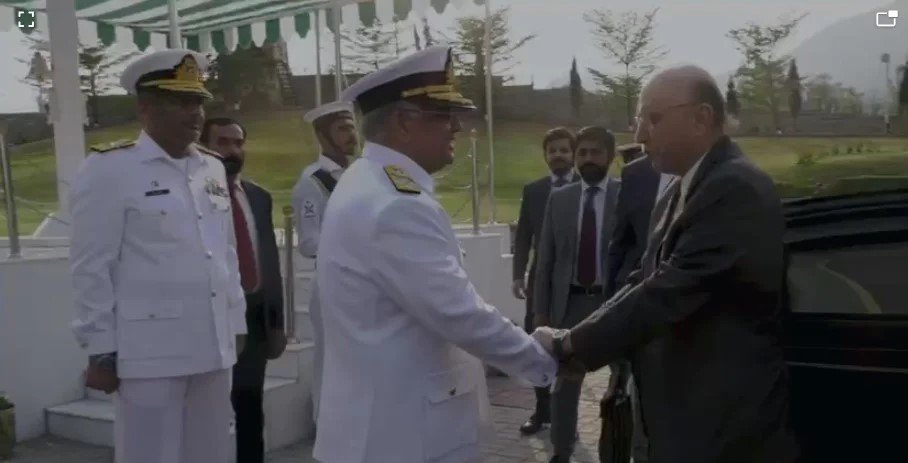In a significant demonstration of Pakistan’s commitment to strengthening its maritime defense, President Asif Ali Zardari recently visited the Pakistan Navy’s Naval Dockyard in Karachi. This visit underscored the country’s ongoing efforts to modernize its naval fleet and enhance the operational capabilities of the Pakistan Navy in a rapidly evolving regional security environment.
The Visit and Its Significance
On September 6, 2024, President Zardari toured the naval shipyard, where he witnessed the induction of two state-of-the-art naval vessels into the Pakistan Navy’s fleet: the PNS Babur, a Milgem-class corvette, and the PNS Hunain, an Offshore Patrol Vehicle. These vessels symbolize Pakistan’s growing naval prowess and its efforts to maintain maritime security in the Arabian Sea and beyond.
The President’s visit was not merely ceremonial. It highlighted Pakistan’s strategic emphasis on safeguarding its maritime borders, protecting sea trade routes, and enhancing its capacity to respond to various maritime threats, including piracy, smuggling, and regional geopolitical tensions.
Modernizing the Fleet: PNS Babur and PNS Hunain
The two vessels inducted during the ceremony represent a quantum leap in Pakistan’s naval capabilities. The PNS Babur is a highly advanced multi-mission corvette designed for anti-surface, anti-air, and anti-submarine warfare. Its induction marks a milestone in Pakistan’s naval modernization program, signaling a shift towards more sophisticated and versatile platforms.
Built in collaboration with Turkey under the Milgem project, the PNS Babur is equipped with modern weaponry, advanced radar and sonar systems, and enhanced maneuverability. The cooperation between Pakistan and Turkey in defense production exemplifies a growing trend of international collaboration to bolster indigenous military manufacturing capabilities.
Similarly, the PNS Hunain serves as a crucial asset for offshore patrol and maritime security missions. Its role primarily revolves around surveillance, search and rescue operations, and protecting Pakistan’s Exclusive Economic Zone (EEZ). The addition of such vessels ensures continuous monitoring of Pakistan’s vast maritime borders and economic interests in the region.
Strategic and Diplomatic Dimensions
President Zardari’s visit was attended by naval officials and international representatives from Turkey and Romania, underscoring the significance of bilateral and multilateral cooperation in defense manufacturing and technology transfer. This aspect of the visit highlighted Pakistan’s strategic partnerships and its efforts to diversify its defense collaborations beyond traditional allies.
The inclusion of foreign delegates in the ceremony also signals Pakistan’s ambition to become a regional hub for naval technology and shipbuilding. Through partnerships like these, Pakistan aims to reduce dependence on external sources for defense equipment and gradually develop its indigenous defense industry.
Emphasis on Maritime Security and Economic Interests
During his visit, President Zardari emphasized the crucial role played by the Pakistan Navy in safeguarding national interests at sea. He paid tribute to the sacrifices of naval personnel and stressed the importance of maintaining a strong and ready navy to protect the country’s maritime trade routes and economic lifelines.
The Arabian Sea is a vital conduit for international trade, with Pakistan’s ports serving as gateways for commerce to and from Central Asia, the Middle East, and beyond. Protecting these sea lanes is not just a military imperative but an economic necessity. Ensuring the security of offshore energy resources and fisheries is also vital for Pakistan’s economic stability.
Pakistan Navy’s Growing Role
The Pakistan Navy has increasingly taken on expanded roles beyond traditional defense. Its responsibilities include humanitarian assistance, disaster relief, anti-piracy operations, and maritime environmental protection. The induction of modern vessels like the PNS Babur and PNS Hunain enhances the navy’s ability to perform these multifaceted tasks effectively.
Rear Admiral Naveed Ashraf, Chief of Naval Staff, acknowledged that these new additions significantly boost Pakistan Navy’s operational readiness. They enhance maritime domain awareness and provide better capabilities to counter emerging threats in the region.
Challenges and Future Outlook
While the induction of new naval vessels marks progress, Pakistan’s maritime security environment remains complex. The region faces challenges such as rising geopolitical tensions, competition for maritime resources, and non-traditional threats like terrorism and piracy. Pakistan’s naval modernization efforts aim to address these challenges by building a credible deterrent and fostering regional stability.
Looking ahead, Pakistan is expected to continue investing in its naval capabilities. Efforts to strengthen indigenous shipbuilding, enhance technological integration, and deepen international partnerships will likely shape the future trajectory of the Pakistan Navy.
Conclusion
President Asif Ali Zardari’s visit to the Pakistan Navy’s Naval Dockyard and the induction of advanced vessels represent a clear message: Pakistan is committed to maintaining a robust naval force capable of defending its maritime interests and contributing to regional security. The visit also reflects a broader strategy of modernizing the armed forces, promoting self-reliance in defense production, and strengthening diplomatic ties through defense cooperation.
As Pakistan navigates a challenging security landscape, the role of its navy will become increasingly critical. The recent developments at the Naval Dockyard in Karachi signify a positive step toward achieving these goals and underscore the strategic importance of maritime security for Pakistan’s national future.
Reference: صدر زرداری کا نیول ہیڈکوارٹر کا دورہ





